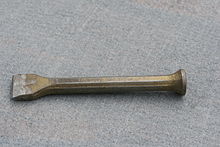Mortising (structural engineering)
In construction , chiselling means removing existing material by hitting it, either manually or mechanically. Hammer and chisel as well as pneumatic, hydraulic or electric rotary hammers are used as tools . The work is always done where space is to be created for new trades .
The results of the caulking process are correspondingly diverse: it can be wall slots for laying cables, or a wall or ceiling breakthrough. During the renovation , ailing material is also removed by chiseling in order to create space for the introduction of new material on a solid surface. Furthermore, in the non-destructive examination of the building stock for structural damage , the chiselling serves to expose the component layers and materials to be examined.
In the case of new buildings, chiselling work is largely avoided thanks to forward-looking planning. First and foremost, this is more economical: it is cheaper to cut out a ceiling opening when pouring the concrete than to chisel it out of the hardened concrete afterwards.
It must always be ensured that load-bearing components are not unduly weakened by the chiselling. If in doubt, a static proof must be provided. In order to avoid weakening, load-bearing components are usually machined by milling (see below). Alternatively, the space requirements of the trades can be taken into account through cutouts in the corresponding components through good foresighted planning.
